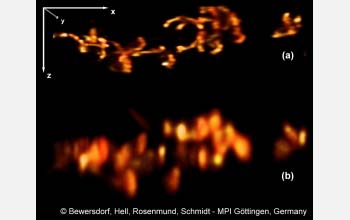News Release 04-115
NSF Funds First U.S-based 4Pi-Confocal Laser Scanning Microscope
New technology will open doors in biophysical research and education

3d-structure of mitochondria in mammalian cells recorded with the Leica TCS 4PI; comparison of ( ...
September 8, 2004
This material is available primarily for archival purposes. Telephone numbers or other contact information may be out of date; please see current contact information at media contacts.
ARLINGTON, Va.—The 4Pi-Confocal Laser Scanning Microscope is world's most advanced light-based microscope—capable of revealing the structure of genetic material within a cell in three dimensions. The first such instrument is now coming to the United States, thanks to a National Science Foundation (NSF) grant to a Maine interdisciplinary biophysical research program.
The Institute for Molecular Biophysics (IMB) brings together expertise in biophysics and engineering at the University of Maine in Orono, molecular and cell biology at the Maine Medical Center Research Institute in Scarborough, and genetics and genomics at The Jackson Laboratory in Bar Harbor. The program's goal: to explore the structure and function of genes and chromosomes within cells in order to understand precisely how genes control both normal development and disease.
"It's been exciting to bring this enabling technology to the talented and diverse group of researchers at the IMB," said Angela Klaus, program director in NSF's division of biological infrastructure, which funded the grant. "High-resolution analysis is a critical next step in genetics and genomics research. Fascinating results should emerge from this research."
The 4Pi microscope will enable the IMB researchers to examine specific structures within a cell–such as a single gene on a chromosome–at a resolution four to seven times greater than conventional confocal microscopy provides.
"Astronomers have space-based telescopes like the Hubble Space Telescope to understand the history and structure of the universe," said IMB co-director Barbara Knowles of The Jackson Laboratory. "Physicists have giant particle accelerators to isolate the fundamental elements of energy and matter. Now researchers in genetics and biology have an advanced tool to examine the very structure of the mouse, human and other genomes."
The 4Pi microscope is manufactured by Leica (Mannheim, Germany), based on technology developed by Stefen Hell of the Max Planck Institute for Biophysical Chemistry in Göttingen, Germany. The "4Pi" designation refers to the unique way in which light is emitted.
"Imagine looking at a satellite image of your state of such high resolution that you can spot the local college football field," said IMB co-director Michael Grunze of the University of Heidelberg in Germany. "Now, imagine being able to see the football, in 3-D. The 4Pi represents a comparable increase in resolution, only on a nanoscale."
The NSF grant for the acquisition of the 4Pi also includes funding for a specialized microscopist, most likely a physicist, to analyze samples on the 4Pi. Grunze foresees that researchers will be able to send or bring biological samples to the IMB for analysis. "I see biology moving towards specialized high-tech centers like the IMB, bringing in investigators from all over the world," he said.
-NSF-
Media Contacts
Cheryl Dybas, NSF, (703) 292-7734, email: cdybas@nsf.gov
Program Contacts
Angela Klaus, NSF, (703) 292-7168, email: aklaus@nsf.gov
The U.S. National Science Foundation propels the nation forward by advancing fundamental research in all fields of science and engineering. NSF supports research and people by providing facilities, instruments and funding to support their ingenuity and sustain the U.S. as a global leader in research and innovation. With a fiscal year 2023 budget of $9.5 billion, NSF funds reach all 50 states through grants to nearly 2,000 colleges, universities and institutions. Each year, NSF receives more than 40,000 competitive proposals and makes about 11,000 new awards. Those awards include support for cooperative research with industry, Arctic and Antarctic research and operations, and U.S. participation in international scientific efforts.
Connect with us online
NSF website: nsf.gov
NSF News: nsf.gov/news
For News Media: nsf.gov/news/newsroom
Statistics: nsf.gov/statistics/
Awards database: nsf.gov/awardsearch/
Follow us on social
Twitter: twitter.com/NSF
Facebook: facebook.com/US.NSF
Instagram: instagram.com/nsfgov


